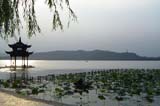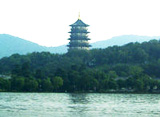Hangzhou LifeHangzhou is the capital of Zhejiang Province, China. Famed for its natural scenery, Hangzhou and its West Lake have been immortalized by countless poets and artists.
With a population of 6.6 million, Hangzhou is recognized as being one of China's beauty spots and best resort city. It is an easy city for the tourist as many of the best sites lie within 15 kilometers. Hangzhou is an important industrial centre and transport hub, with the quality of silk produced here being legendary.
The city of Hangzhou was founded about 2,200 years ago during the Qin Dynasty.It is one of the cradles of China civilization and one of the Seven Ancient Capitals of China. As early as over 5,000 years ago, there were human beings living in the Hangzhou area, creating the Liangzhu Culture known as the Dawn of Civilization. In the 13th century, the Italian traveler Macro Polo called Hangzhou "the Most Splendid and Luxurious City in the World". Hangzhou was called Qiantang in ancient time. In the ninth year of Kaihuang of Sui Dynasty (589 AD), Hangzhou was founded to replace the original Qiantang County and the name of Hangzhou was recorded for the first time in history. In the third year of Jianyan of Southern Song Dynasty (1129 AD), Emperor Gaozong moved southward to Hangzhou and upgraded it as the site of the prefecture city of Lin'an. In the eighth year of Shaoxing (1138 AD), Lin'an was officially determined as the capital, which lasted more than 140 years. In the first year of the Republic of China (1912), the original Qiantang County and Renhe County were merged into Hangzhou County. In the 16th year of the Republic of China (1927), Hangzhou County was dismantled and Hangzhou was founded as a city. It was on May 3, 1949 when Hangzhou was liberated that the city began to write its new chapter of development in history.
The Grand Canal, originating in Beijing, was extended to Hangzhou, thus linking the city to the most profitable trading route in China. Since the city wall was constructed during the Sui Dynasty in 591, Hangzhou became increasingly powerful and prosperous.
It was the capital of the Wuyue Kingdom from 907 to 978 during the Five Dynasties and Ten Kingdoms Period. Named Xifu at the time, it was one of the three great centers of culture in southern China during the 10th century, along with Nanjing and Chengdu. Leaders of Wuyue were noted patrons of the arts, and especially of Buddhism and associated temple architecture and artwork. It also became a cosmopolitan center, drawing scholars from throughout China and conducting diplomacy not only with neighboring Chinese states, but also with Japan, Korea, and the Khitans. In 1089, a 2.8 kilometer long dike was built across the West Lake. The lake was once a lagoon tens of thousands of years ago. Silt then blocked the way to the sea and the lake was formed. A drill in the lake-bed in 1975 found the sediment of the sea, which confirmed its origin. Artificial preservation prevented the lake to evolve into a marshland. The Su Dike built by Su Shi, and the Bai Dike built by Bai Juyi, a famous Tang Dynasty Poet who was once the governor of Hangzhou, are both built out of the mud cleaned from the bottom of the Lake. The Lake is surrounded by hills on north and west side. The Baochu Pagoda sits on the Baoshi Hill to the north of the Lake. The city was the capital of the Southern Song Dynasty from 1127 AD until the Mongol invasion of 1276. This period was Hangzhou's golden age of prosperity. Local industry flourished and worship of Taoism and Buddhism peaked. Many of the temples seen today were built during that period. During the Southern Song Dynasty, commercial expansion, an influx of refugees from the conquered north, and the growth of the official and military establishments, led to a corresponding population increase and the city developed well outside its 9th century ramparts. It is believed that Hangzhou was the largest city in the world from 1180 to 1315 and from 1348 to 1358. Mongols ruled China and Marco Polo visited Hangzhou in 1290 and referred to the city as "beyond dispute the finest and the noblest in the world." Although he exaggerated that the city was over one hundred miles in diameter and had 12,000 stone bridges, he still presented elegant prose about Hangzhou, stating "the number and wealth of the merchants, and the amount of goods that passed through their hands, was so enormous that no man could form a just estimate thereof." And he was so overwhelmed by the beauty of the Xi Hu, or West Lake, that he transcribed, and thus popularized, a famous Chinese saying "Shang you tiantang, xia you Suhang", which means in heaven there is paradise, on earth there is Suzhou and Hangzhou. Chinese now like to call Hangzhou "Paradise on Earth". Hangzhou was the capital of the Southern Song Dynasty from the early 12th century until the Mongol invasion of 1276, and was known as Lin'an. It served as the seat of the imperial government, a center of trade and entertainment, and the nexus of the main branches of the civil service. During that time, the city was the gravity centre of Chinese civilization as what used to be considered the "central China" in the north was taken by the Jin, an ethnic minority dynasty. Numerous philosophers, politicians, and men of literature, including some of the most celebrated poets in Chinese history such as Su Shi, Lu You, and Xin Qiji came here to live and die. Hangzhou was also the birthplace and final resting place of the famed scientist Shen Kuo (1031-1095 AD), his tomb located in the Yuhang district in Hangzhou. The city remained an important port until the middle Ming dynasty when its harbor slowly silted up. Hangzhou continued to grow and prosper from its local industries, especially silk weaving, and became the silk center for all of China. As late as the latter part of the 16th and early 17th centuries, the city was an important center of Chinese Jewry, and may have been the original home of the more well-known Kaifeng Jewish community.
It is at 30.15 degrees north latitude and 120.16 degrees east longitude. In southwest Hangzhou there is a foothill, joined by the undulated Tianmu Mountains, with an altitude generally lower than 500 meters. The northeastern part of the city is flat, with an altitude of 3 to 10 meters. The city centre is built around the eastern and northern sides of the West Lake, just north of the Qiantang River.
Hangzhou, the capital of Zhejiang Province at the sub-provincial administrative level, is the provincial center in politics, economy, culture, science and education. It is also an important national tourist city with its beautiful scenery and a famous city in history & culture affirmed by the State Council. The economy of Hangzhou has been developed consistently and rapidly. Its general economic strength is one of the top ten in China and its GDP is ranked number two among the provincial capitals in China. Hangzhou is an industrial city with complete kinds and major in light industry, which is considered as the most important manufacturing base and logistics hub. Light industrial economy of Hangzhou ranks tops in the country. In Hangzhou, there is the biggest flax textile factory in China. The silk industry has a very long history and the output and quality of the products are ranked first in China. Hangzhou has made significant progress in developing its foreign economic relations and trade, which plays an important part in Hangzhou's economy. Samsung, Nokia, Motorola, Siemens and Ericsson have all set up research and development centers in Hangzhou. Yahoo invested US$1 billion in hangzhou-based Alibaba in 2005, in the largest dotcom merger in China to date. Alibaba is China's biggest e-commerce website. In 2006, Chinese internet and online games provider NetEase.com set up a RMB304 million research and development center in the city. Moreover, the agricultural sideline occupations are developed too. The agricultural foundation of Hangzhou is rather solid-- fertile soil and rich natural resources, a temperate climate and abundant rainfall. Therefore, the development of production of agricultural sideline products looks promising. Hangzhou's real estate market has been booming.Sun Hung Kai of Hong Kong took a 40% stake in a US$90 million property development venture with China Resources in 2005. Hangzhou's construction boom has proved draw for machinery producers. For instance, a Japanese owned excavator manufacturing venture involving Toyota Tsusho and Kobe Steel was set up in the city in 2005. A World Bank report published in October 2006 ranked Hangzhou as the leading Chinese city in terms of overall investment climate, local government effectiveness and progress towards a harmonious society. More than 50 of the world's top 500 companies have invested In Hangzhou.
Hangzhou owns the natural environment integrating rivers, lakes and hills. The hilly area of the city accounts for 65.6 percent of the total, the plain 26.4 percent, rivers, lakes, ponds and reservoirs 8 percent. Its west, middle and south belong to the hilly area of West Zhejiang and northeast to the plain of North Zhejiang. The Grand Cannal (Beijing-Hangzhou) is the longest cannel in the world and Qiantang River, noted for its huge waves. Hangzhou has long been reputed as the Land of Fish and Rice, the Land of Silk and Paradise on the Earth with lengthwise and sidewise rivers. With its densely scattered lakes, Hangzhou is a beautiful place to enjoy the scenery without worries. In fact, Hangzhou was the first provincial capital to be designated a model environmental city by the central government in 1998. It has one of the best air quality indices of any major Chinese city, while its per capita urban green space amounts to 6.8 square meters. Hangzhou is the center of politics, economy and culture of Zhejiang province. Hangzhou is equipped with a sound infrastructure system. As an important hub of communications, Hangzhou is equipped with a complete land, water and air transportation systems. Hangzhou has also seen a rapid development of its telecommunications. At present, the city is making endeavor to make itself a city of powerful economic strength, diversified culture and modernized world-renowned tourist site. |





